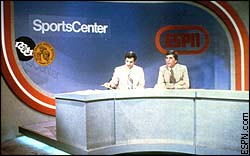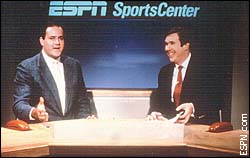| | 1978
Bill Rasmussen, ESPN founder, hosts press conference in Plainville, Conn. to announce preliminary plans for sports television network (June 26).
Bristol, Conn. site recommended and plans for construction of base of operations are devised (August 17).
RCA awards ESPN Satcom I satellite positions (Sept. 20).
| |  | | The sets weren't as flashy, but the commentary was just as good. |
1979
Getty Oil purchases 85 percent of ESPN (Feb. 22).
The NCAA grants ESPN exclusive rights to telecast collegiate events (March 1).
Anheuser-Busch signs the largest advertising contract in the history of cable television with ESPN (May 30).
ESPN is launched at 7 p.m. ET across the country with airing of SportsCenter (Sept. 7).
Prominent sports announcer Jim Simpson joins ESPN from NBC, lending instant credibility to the fledgling network (Sept. 14).
ESPN televises first NHL game (Washington at Hartford Dec.19).
1980
ESPN televises 23 NCAA Basketball Tournament games (March).
ESPN televises live the NFL Draft (April 29).
Continuous round-the-clock telecasts begin (Sept. 1).
1981
Subscriber count climbs to more than 10 million homes (May 31).
Getty and ABC Video announce letter of intent for pay sports venture involving ESPN; deal also involves supplementary coverage by ESPN of various events from ABC and an option for ABC to acquire 10 percent of ESPN (Sept. 23).
ESPN's first flag-to-flag coverage of a NASCAR race (Nov. 8).
1982
ESPN and the NBA agree to a two-year deal (January 30).
ESPN becomes the first network to televise every round of a PGA Tour event, the USF&G from New Orleans (April 22-26).
ESPN President Chester Simmons leaves ESPN to become the first commissioner of the USFL and is succeeded by J. William Grimes (June 14).
ESPN provides coverage of the John McEnroe-Mats Wilander Davis Cup match that lasted 9:30, the longest live sports telecast in national television history (July 11).
1983
ESPN televises the first live professional football game on cable, the USFL's Birmingham against Michigan (March 7).
ESPN begins distributing programming internationally (April).
ESPN interrupts scheduled programming for the first time to provide coverage of the seventh race of the America's Cup (Sept. 26).
ESPN becomes the largest cable network, reaching 28.5 million homes (Oct. 1).
1984
ABC purchases 15% of ESPN from Getty Oil and is given the option to obtain as much as 49% by 1986 (Jan. 2).
Getty and Texaco merge, allowing ABC to purchase the remaining 85% of ESPN (Jan. 8).
ABC Video Enterprises finalizes acquisition of ESPN (June 18).
ESPN awarded its first live college football agreement, 15 primetime College Football Association games (July 25).
ABC sells 20% of ESPN to Nabisco (Sept. 11).
BYU earns the national title on ESPN with its win in the Holiday Bowl (Dec. 21).
ESPN debuts in Hawaii and becomes available in all 50 states (Dec. 31).
| |  | | SportsCenter: 1980's style. |
1985
New logo and new corporate name -- ESPN, Inc.-- adopted (Feb. 4).
Georgetown/St.John's college basketball game becomes the network's highest-rated national telecast, reaching 2.9 million homes (Feb. 27).
ESPN signs a three-year deal with the NHL (July 25).
"28/58" score update debuts (July 26).
1986
Expanded coverage of post-season college basketball conference tournaments (later called "Championship Week") features 27 games and provides electronic cut-ins to 45 other games (March 13).
Extensive Stanley Cup playoff coverage begins, featuring 35 games in 50 days, including Stanley Cup Finals. Network utilizes electronic cut-ins, cutting to other live games 115 times, plus 80 times on tape (April 9).
1987
ESPN provides groundbreaking, innovative coverage of the America's Cup from Australia; overwhelming public and media reaction proves impact of cable and ESPN (Jan.).
NFL awards ESPN the first cable television agreement, featuring 13 telecasts and the Pro Bowl (March 15).
NY Islanders at Washington Capitals playoff game goes into four overtimes and becomes the longest televised game in NHL history. ESPN provides six-and-one-half hours of live coverage from start to finish (April 18).
ESPN becomes the first cable network to achieve 50% penetration in the American television market, reaching 43.7 million homes (July 23).
1988
Roger L. Werner succeeds Bill Grimes as President and CEO of ESPN (August 17).
ESPN's 1987-88 NCAA Basketball open earned ESPN a Sports Emmy award in its first year of eligibility. This was the first Emmy ever received by a cable network (July 13).
ESPN begins 48-game college football schedule - the most games ever on national television (Sept. 1).
ESPN airs its 10,000th SportsCenter, the most televised cable program in history (Dec. 2).
1989
ESPN and Major League Baseball agree to a four-year, $400 million contract beginning in 1990. ESPN will televise 175 games each season (Jan. 5).
ESPN International debuts live service -- to Latin America (March).
ESPN celebrates 10th anniversary with a gala and a 90-minute special (Sept. 7).
SportsCenter provides first live national reports from the earthquake at the Oakland-San Francisco World Series (Oct. 17).
1990
Outside the Lines premieres (May 7).
Steve Bornstein is named President and CEO of ESPN, replacing Roger Werner (Sept. 10).
The Hearst Corporation purchases RJR/Nabisco's 20% share in ESPN (Nov. 8).
1991
ESPN chronicles Nolan Ryan's seventh career no-hitter with live cut-ins. Ryan's no-hitter is the first of three televised by the network (May 1).
ESPN finalizes its agreement for majority interest in The European Sports Network (Sept. 23).
ESPN returns to an all-sports format when the network replaces its morning business news program Nation's Business Today with re-airs of SportsCenter (Sept. 30).
1992
ESPN Radio Network is launched featuring 16 hours a week of sports news and information (Jan. 1).
A new look "Big Monday" debuts with Big East, Big Eight and Big West tripleheaders. Big Ten games are now seen on Tuesdays preceding SEC contests (Jan. 6).
ESPN televises more than 100 live hours of programming from the 1992 America's Cup in San Diego (Jan. - May).
ESPN and ABC Sports announce an agreement to televise the entire 52-game 1994 FIFA World Cup soccer tournament when it is held for the first time in the United States. ESPN will televise 41 games from the 24-team tournament (June 3).
1993
First ESPY Awards held in New York (March 4).
ESPN forms "The V Foundation" with Jim Valvano (March 4).
ESPN acquires the sports programming and sports sales of OCC (March 16).
ESPN2 launches in 10 million households (Oct. 1).
1994
The hour-long nightly SportsCenter moves to 11 p.m. ET (April 3).
ESPN and ESPN2 combine to televise the entire NFL Draft for the first time (April 24-25).
ESPN acquires Creative Sports (now ESPN Regional Television) (May 9).
ESPN International begins service to 25 countries in the Middle East and Northern Africa and adds 18 more countries in Southern Africa one week later (May 25).
ESPN and Tommy Boy Records release Jock Rock, a CD of popular songs heard at games. The album goes Gold, peaking at #79 on the Billboard chart.
1995
ESPNET SportsZone (now ESPN.com) is launched during Final Four Weekend (April 1).
ESPN/ESPN2 provide 45.5 hours of coverage from the first Extreme Games (now X Games), held in Rhode Island (June 24-July 1).
Capital Cities/ABC, Inc. and The Walt Disney Company announce plans to merge (July 31).
ESPN televises live Cal Ripken's record breaking 2,131st consecutive game, surpassing Lou Gehrig (Sept. 6).
ESPN Radio acquires exclusive broadcast rights for the NBA (Nov. 14).
1996
FCC gives approval to merger of Capital Cities/ABC, Inc. and The Walt Disney Company (Feb. 9).
"Bottom Line2" debuts on ESPN2 with continuous scores and news (March 1).
ESPN provides exclusive coverage of the NCAA Women's Basketball Tournament for the first time (March).
ESPN wins 11 Sports Emmy Awards, its most ever and, for the second time (1994) the most of any network.
Steve Bornstein adds responsibility as President, ABC Sports (May 6).
ESPN televises the Major League Baseball playoffs, marking the first time the playoffs are on cable (Oct. 1-5).
ESPNEWS launches (Nov. 1).
1997
Winter X Games debut in Big Bear Lake, Calif. (Jan. 30-Feb.1).
The Walt Disney Company purchases a significant equity stake in Starwave Corporation, co-producer (with ESPN) of ESPN SportsZone, the most popular destination site on the Internet. ESPN Internet Ventures is formed (April 3).
ESPN's 12-game inaugural WNBA schedule culminates with a simulcast of the playoff semifinals with the Lifetime network (Aug. 28).
ESPN acquires Classic Sports Network (now ESPN Classic) (Oct. 8).
Hyperion announces a line of books to be published in conjunction with ESPN, beginning with the 1998 ESPN Information Please Sports Almanac.
1998
ESPN International marks its 15th anniversary by adding service to Antarctica, making ESPN available on every continent (Jan.).
ESPN adds first half of NFL season and again becomes the exclusive cable carrier of the NFL through 2005 (Jan. 13).
ESPN The Magazine debuts (March 11).
ESPN acquires the Big Fights Library, Inc. (May 12).
20,000th SportsCenter is aired (May 17).
ESPN Zone opens in Baltimore (July 11).
ESPN and ABC sign an exclusive agreement with the NHL through 2004 (Aug. 25).
ESPN provides live coverage of Mark McGwire's record-tying 61st home run, which was ESPN's highest rated MLB telecast ever, earning a 9.5 rating (Sept. 7).
An ESPN specialty area opens in 100 Sears stores nationwide; 500 more to follow in the next year (Oct.).
Steve Bornstein is named Chairman of ESPN and George Bodenheimer is named President (Nov. 19).
1999
ESPN announces the creation of the Great Outdoor Games to be held in Lake Placid, N.Y. in 2000 (Jan. 20).
ESPN unveils SportsCentury, an 18-month series reviewing the greatest sporting events, athletes, coaches and developments of the past 100 years (Jan. 22).
George Bodenheimer assumes responsibility for all of ESPN, Inc.'s domestic and international operations and Steve Bornstein becomes President of ABC, Inc. (March 1).
SportsCenter begins airing at 10 p.m. PT (April 6).
ESPN and ESPN2 televise 30 Women's World Cup Games (June and July).
ESPN2 becomes the fastest network to reach 65 million homes (August).
| |
|



